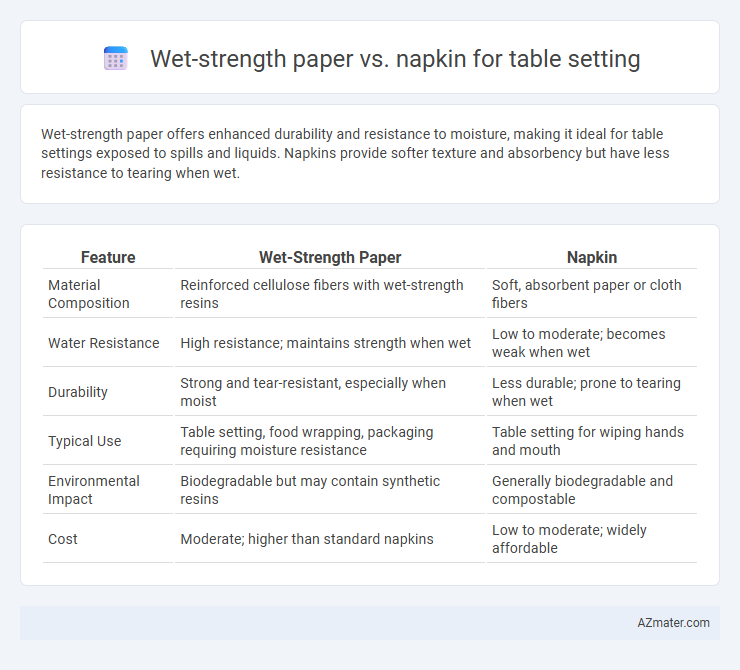Wet-strength paper offers enhanced durability and resistance to moisture, making it ideal for table settings exposed to spills and liquids. Napkins provide softer texture and absorbency but have less resistance to tearing when wet.
Table of Comparison
| Feature | Wet-Strength Paper | Napkin |
|---|---|---|
| Material Composition | Reinforced cellulose fibers with wet-strength resins | Soft, absorbent paper or cloth fibers |
| Water Resistance | High resistance; maintains strength when wet | Low to moderate; becomes weak when wet |
| Durability | Strong and tear-resistant, especially when moist | Less durable; prone to tearing when wet |
| Typical Use | Table setting, food wrapping, packaging requiring moisture resistance | Table setting for wiping hands and mouth |
| Environmental Impact | Biodegradable but may contain synthetic resins | Generally biodegradable and compostable |
| Cost | Moderate; higher than standard napkins | Low to moderate; widely affordable |
Introduction to Table Setting Essentials
Wet-strength paper offers enhanced durability and moisture resistance, making it ideal for table settings where spills and damp conditions are common. Napkins, typically made from softer, absorbent materials, prioritize comfort and elegance but may lack the robustness needed for heavy use. Choosing between wet-strength paper and traditional napkins depends on balancing functionality with aesthetic appeal in table presentation.
Understanding Wet-Strength Paper
Wet-strength paper contains chemical additives that enhance its resistance to moisture, making it ideal for table settings where spills are common. Unlike regular napkins, wet-strength paper maintains structural integrity when damp, preventing disintegration and providing reliable cleanup. This durability ensures a more hygienic and practical option for restaurants and events requiring strong, absorbent tableware.
What Are Napkins? Types and Materials
Napkins are essential table linens designed to protect clothing and enhance dining decor, typically made from materials like cotton, linen, or paper. Paper napkins vary between standard and wet-strength types, with wet-strength paper napkins treated to resist tearing and moisture, ideal for messy meals or outdoor settings. Cloth napkins, crafted from fabrics such as cotton or polyester blends, offer durability and a reusable, eco-friendly option for formal or casual table settings.
Durability: Wet-Strength Paper vs Napkin
Wet-strength paper offers superior durability compared to traditional napkins due to its enhanced resistance to tearing and disintegration when exposed to moisture. This makes wet-strength paper ideal for table settings where spills and dampness are common, maintaining structural integrity throughout the meal. Napkins, while absorbent, tend to weaken and tear quickly when wet, limiting their effectiveness in maintaining a neat and clean dining experience.
Absorbency Comparison
Wet-strength paper exhibits superior durability and moisture retention compared to regular napkins, making it ideal for table settings requiring high absorbency under wet conditions. Its enhanced fiber bonding resists disintegration when exposed to liquids, maintaining structural integrity during use. Napkins, while effective for light spills, often lack the wet-strength properties necessary for heavy absorbency, leading to quicker saturation and breakdown.
Aesthetic Appeal and Texture
Wet-strength paper offers enhanced durability and resistance to moisture, maintaining its texture and structural integrity during use, which ensures a polished aesthetic appeal suitable for upscale table settings. Napkins, often made from softer, more absorbent materials like cotton or recycled paper, provide a more delicate texture and an inviting, cozy look but may lack the robust feel of wet-strength paper. The choice between the two depends on the desired balance between practical durability and tactile softness in the dining experience.
Cost-Effectiveness and Value
Wet-strength paper napkins provide superior durability and resistance to moisture, making them ideal for messier meals and reducing the need for multiple napkins, which enhances overall cost-effectiveness. While traditional napkins are generally cheaper upfront, their lower durability often results in higher consumption and waste, decreasing long-term value. Investing in wet-strength paper offers a balance of affordability and performance, benefiting both casual dining and commercial table settings seeking sustainable and efficient solutions.
Environmental Impact and Sustainability
Wet-strength paper is engineered with chemical additives to resist tearing when moist, extending its usability but complicating biodegradability and recycling processes, which can increase environmental impact. Napkins, particularly those made from recycled or unbleached paper, offer a more sustainable option, breaking down faster and reducing landfill waste. Choosing napkins made from sustainably sourced fibers supports environmental conservation and lowers carbon footprints in table setting practices.
Practicality for Different Occasions
Wet-strength paper offers enhanced durability and moisture resistance, making it ideal for outdoor events, picnics, or settings involving heavy usage. Napkins, available in various materials like cloth or standard paper, provide versatility and elegance, suitable for formal dinners or casual gatherings with lighter spill potential. Choosing between wet-strength paper and napkins depends on balancing practicality with the occasion's formality and expected mess, where wet-strength paper excels in robustness, and napkins excel in aesthetic appeal.
Choosing the Right Option for Your Table Setting
Wet-strength paper offers superior durability and moisture resistance, making it ideal for table settings where spills are common. Napkins, particularly cloth varieties, provide a more elegant and reusable option, enhancing the dining experience with a touch of sophistication. Choosing between wet-strength paper and napkins depends on the desired balance of functionality and ambiance for your table setting.

Infographic: Wet-strength paper vs Napkin for Table setting
 azmater.com
azmater.com